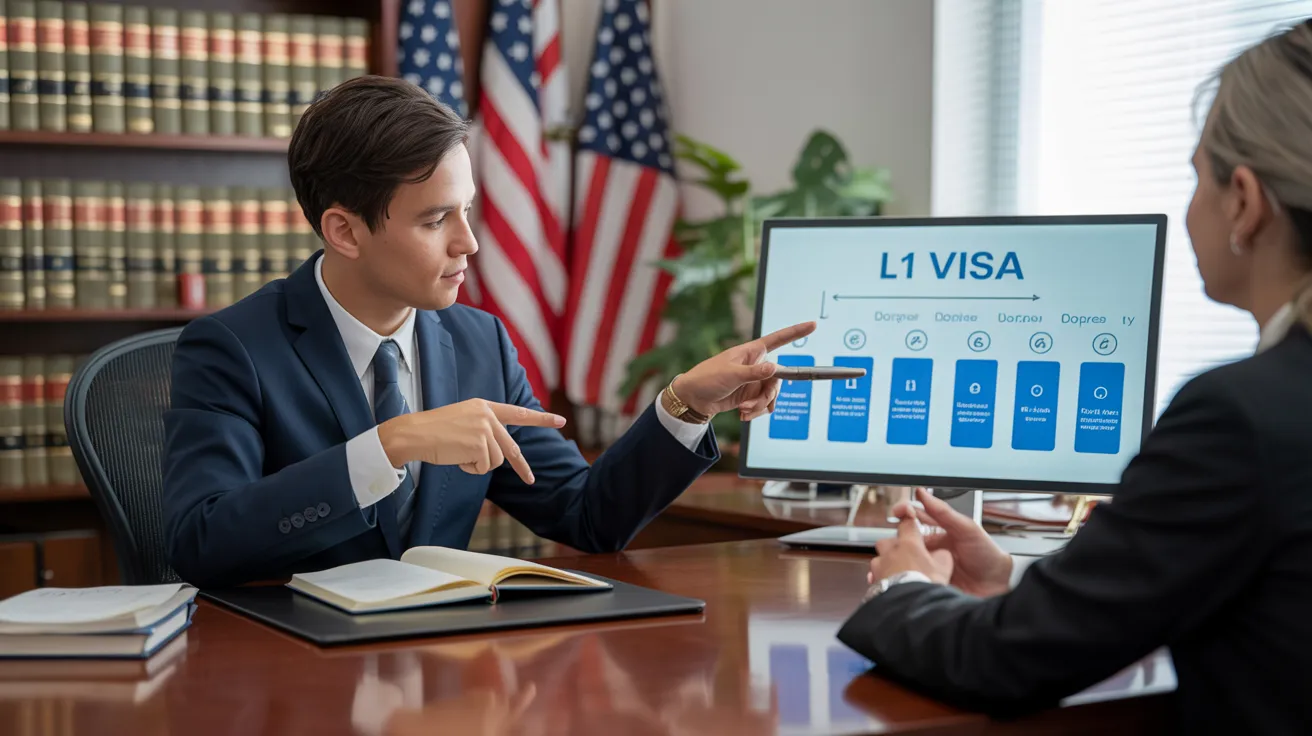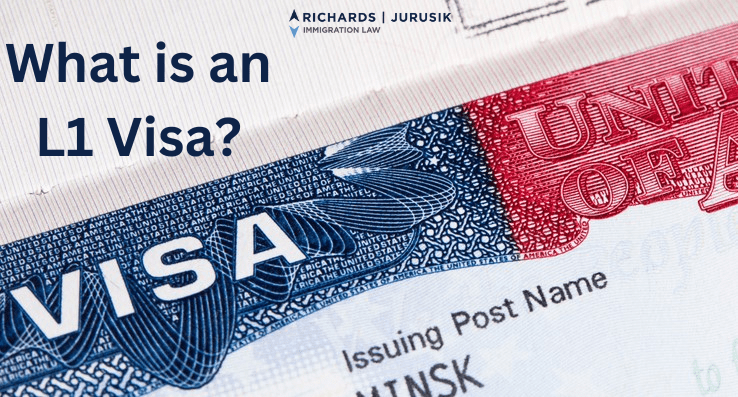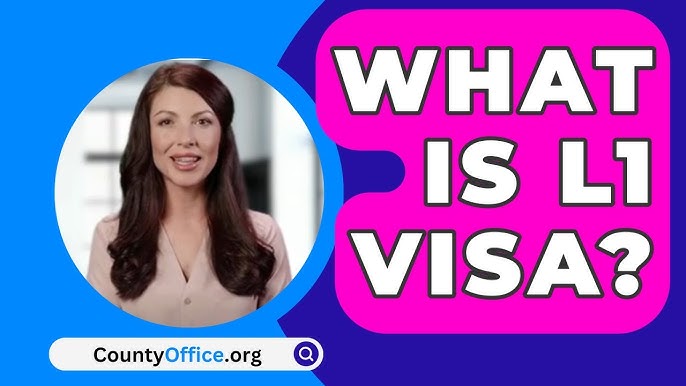Unlocking Opportunities: A Comprehensive Guide to the L1 Visa Process
The L1 visa procedure provides an essential pathway for multinational firms seeking to move key staff members across borders. Recognizing the subtleties of eligibility standards, the distinctions between L-1A and L-1B visas, and the details of the application procedure can significantly affect an applicant's success. Maneuvering this complex landscape is not without its obstacles, and mindful focus to documentation and employer sponsorship is essential. As we check out the key parts of this process, the methods for overcoming possible obstacles will end up being obvious, disclosing how educated preparation can open a globe of opportunities.
Recognizing the L1 Visa
Understanding the L1 visa involves acknowledging its significance as a vital device for international business seeking to transfer skilled staff members in between global offices. This non-immigrant visa group assists in the motion of execs, supervisors, and specialized knowledge workers to the United States, consequently making it possible for companies to maintain functional connection and harness global talent efficiently. The L1 visa is separated right into 2 primary categories: L-1A for managers and executives, and L-1B for workers having specialized knowledge.The L1 visa serves a vital role in boosting a firm's affordable edge in the international market. By permitting firms to transfer their vital workers, businesses can ensure that crucial projects are handled by certified individuals that are already knowledgeable about the company's culture and functional procedures. L1 copyright copyright. This internal transfer device not only promotes expertise sharing however likewise advertises development and collaboration across borders.Moreover, the L1 visa is typically preferred for its relatively straightforward application process contrasted to various other visa classifications, as it permits dual intent, allowing owners to seek irreversible residency while on a momentary job visa. This feature makes the L1 visa especially appealing for both employers and staff members, as it enhances the path for proficient specialists to establish long-term residency in the USA
Eligibility Requirements
Eligibility for the L1 visa hinges on a number of vital standards that ensure both the employee and the company meet certain certifications. This non-immigrant visa is created for multinational firms to move employees from consular services to united state counterparts.Firstly, the company has to be a certifying company, that includes a moms and dad firm, branch, affiliate, or subsidiary of a united state service. The company has to have been doing company for at the very least one year both in the U.S. and abroad. This assures that the firm has enough operational stability and a genuine presence.Secondly, the staff member needs to hold a supervisory, executive, or specialized expertise placement. For L1A visas, the candidate should demonstrate supervisory or executive credentials, while L1B visas concentrate on specialized understanding pertaining to the company's items, solutions, or procedures. Additionally, the staff member has to have worked for the international entity for a minimum of one continuous year within the last three years prior to their application.Lastly, the worker's role in the united state must align with their previous position, guaranteeing that their abilities and know-how are leveraged for the business's advantage.

Sorts Of L1 Visas
The L1 visa group consists of 2 key kinds designed to help with the transfer of workers within multinational business: the L1A visa for managers and executives, and the L1B visa for staff members with specialized expertise. Each type serves unique objectives and has specific eligibility criteria.The L1A visa is tailored for people who hold supervisory or executive settings within a firm. This visa enables high-level staff members to transfer to a united state branch, subsidiary, or associate of the very same company. Candidates for the L1A visa have to show that they have been utilized in a managerial or executive capacity for at least one constant year within the previous 3 years before their application. In addition, this visa uses a longer duration of stay, originally approved for 3 years, with the opportunity of extensions for up to seven years.In contrast, the L1B visa is meant for specialists with specialized knowledge associated to the business's products, services, or procedures. To qualify, candidates have to confirm that their proficiency is important to the company which they have actually worked for a minimum of one continuous year within the last 3 years in a function that required this specialized expertise. The L1B visa is at first granted for three years, with extensions readily available for approximately five years.Both visa kinds are important for companies looking for to boost their international operations by leveraging proficient workers, thereby advertising technology and effectiveness within the U.S. market.
Application Process
Steering via the L1 copyright process entails a number of vital actions that must be diligently complied with to ensure an effective result. The procedure begins with the U.S. employer, who have to initially establish eligibility by showing a qualifying relationship with the international entity and confirming that the staff member fulfills the details requirements for the L1 visa category being sought.Once qualification is verified, the employer launches the procedure by filing Form I-129, the Application for a Nonimmigrant Worker, with the United State Citizenship and Migration Provider (USCIS) This kind should be accompanied by a thorough description of the task duties to be done, the business framework of both the U.S. and international entities, and the worker's qualifications. It's vital to verify that all info is exact and complete, as omissions or mistakes can result in hold-ups or denials.Upon approval of the I-129 request, the following step includes the staff member making an application for the L1 visa at a united state consular office or consulate in their home country. This stage needs the conclusion of Type DS-160, the Online Nonimmigrant copyright, and setting up an interview. During the meeting, the candidate should provide evidence sustaining their credentials and the employer's petition.After the visa is approved, the staff member can get in the United States to work in the assigned function. In general, cautious preparation and adherence to every step of the application process are vital for an effective L1 visa outcome.
Required Documents

Vital Kinds Needed
Steering the L1 Visa process needs cautious interest to the important kinds and documents essential for a successful application. The primary kind needed is the Type I-129, Application for a Nonimmigrant Worker, which have to be finished and submitted by the united state company (L1 Visa Requirements). This kind describes the information of the employment offer and the certifications of the worker seeking the L1 Visa.Alongside Type I-129, the applicant will require to complete Type I-539 if accompanying member of the family are also making an application for visas. In addition, the employer must offer proof of the qualifying relationship between the united state entity and the international entity, usually necessitating the submission of company papers such as posts of incorporation or economic statements.Moreover, it is important to include the L Classification Supplement to Form I-129, which defines the kind of L Visa being requested-- either L-1A for managers and executives or L-1B for workers with specialized knowledge. Candidates ought to guarantee that all forms are authorized and dated appropriately, as insufficient entries can lead to hold-ups or rejections. Correctly putting together these important forms lays the structure for a smoother L1 copyright process
Supporting Proof Requirements
Sustaining paperwork is vital for a successful L1 copyright, as it confirms the insurance claims made in the application. Candidates must offer a series of documents to demonstrate eligibility for the visa, which is classified right into two main types: proof of the qualifying connection in between the U.S. and foreign entities and evidence of the applicant's qualifications.To develop the partnership, applicants need to send paperwork such as company business charts, financial declarations, and proof of ownership. These documents verify that the foreign firm has a qualifying partnership with the U.S. company, whether as a parent company, subsidiary, branch, or affiliate.For the candidate's certifications, vital documents consist of a detailed employment letter from the foreign employer, detailing the candidate's job title, duties, and duration of work. Furthermore, academic credentials, such as levels and diplomas, should be provided to prove the candidate's expertise in the pertinent field.
Company Sponsorship Files
Employer sponsorship files play an important function in the L1 copyright procedure, as they confirm the U.S. company's dedication to the candidate's employment in the United States. These papers are vital for showing the employer's eligibility to sponsor the applicant for the L1 Visa.Key files usually needed consist of a comprehensive employment letter from the united state employer, which lays out the work title, duties, and the nature of the work connection. Furthermore, the company needs to supply proof of the company's authenticity, such as company licenses, income tax return, and business charts, highlighting the connection in between the united state entity and the international company.Furthermore, evidence of the employee's qualifying relationship with the foreign firm is needed. This may include documentation confirming the staff member's function in the international entity, such as pay stubs, work agreements, or performance assessments.
Common Difficulties
Navigating the L1 visa process provides several typical challenges that applicants ought to recognize (L1 Visa). Secret problems often consist of stringent paperwork demands, potential delays in processing times, and the need for stringent lawful conformity. Understanding these obstacles can help applicants much better prepare and reduce threats throughout L1 Visa their copyright journey
Documentation Demands
The L1 copyright process frequently offers significant challenges associated with documentation requirements. Applicants must give extensive documentation to establish eligibility, which can result in complication and prospective hold-ups. Key records include evidence of a qualifying relationship in between the united state and foreign employer, proof of the applicant's employment background, and comprehensive details concerning the work role in the U.S.One typical challenge is collecting adequate proof to show the nature of the qualifying partnership. Firms commonly have a hard time to present clear business graphes or financial declarations that illustrate the link between the entities. In addition, ensuring that letters of support from companies properly show the candidate's job obligations and certifications is necessary, as unclear summaries can lead to denials.Another issue occurs from the requirement for thorough task descriptions that line up with the L1 visa categories. Applicants must express not only their existing duty yet additionally their supervisory or specialized knowledge obligations plainly. This necessitates a comprehensive understanding of both the applicant's setting and the regulative language made use of in L1 applications.
Processing Time Delays
Experiencing delays in handling times is a typical challenge encountered by L1 visa applicants, usually leading to aggravation and uncertainty. Several aspects contribute to these delays, including high application quantities, enhanced examination of applications, and management stockpiles within the united state Citizenship and Migration Provider (USCIS) Candidates may discover that processing times can vary considerably depending on the service facility handling their application, as each facility has its own workload and efficiency levels. Furthermore, the complexity of the candidate's situation, such as the requirement for substantial paperwork or information, can additionally prolong wait times.In some circumstances, problems connected to the applicant's present immigration condition or previous visa background may likewise cause additional hold-ups, as USCIS may require additional review or info. It is necessary for prospects to remain positive during this period, maintaining open interaction with their companies and lawful reps to address any type of possible issues promptly.Understanding these handling time challenges can help L1 visa candidates get ready for feasible delays and reduce the effect on their shift and career strategies. Perseverance and diligence are essential virtues in steering this elaborate procedure.
Legal Conformity Issues
Many L1 visa candidates encounter lawful compliance concerns that can complicate their journey towards getting the visa. Recognizing and sticking to the specific laws set by the U.S. Citizenship and Migration Solutions (USCIS) is vital. Common obstacles include showing the certifying relationship between the foreign and united state companies, along with showing that the candidate has the requisite specific knowledge or supervisory capacity.Additionally, applicants need to provide complete documents detailing their work duties, company framework, and financial feasibility of the U.S. entity. Inadequate or incorrect documents can result in delays or perhaps denials. Employers should likewise ensure that they adhere to labor regulations, consisting of wage and functioning problem standards, which can impact visa eligibility.Another common issue includes maintaining compliance with the regards to the visa as soon as granted. Modifications in work standing, work duties, or company framework can demand changes to the visa, which if not resolved without delay can lead to lawful problems. Because of this, staying notified regarding compliance demands and seeking legal counsel when necessary is vital to browse the complexities of the L1 visa procedure successfully.
Tips for Success
Success in the L1 copyright procedure typically depends upon careful prep work and attention to information. To improve your opportunities of authorization, begin by thoroughly comprehending the eligibility needs for both the L1A and L1B visa categories. Evaluate whether your setting at the firm certifies as managerial, exec, or specialized understanding, as this classification especially influences your application.Next, collect extensive documents that substantiates your cases. This consists of organizational charts, thorough work summaries, and evidence of the company's functional structure. Clear and succinct proof of the certifying relationship between the united state entity and the international entity is essential. Verify that all records are arranged practically and presented in an expert way, as this mirrors your dedication and severity about the application.Engage the solutions of a skilled migration attorney that focuses on L1 visas. Their expertise can verify very useful, assisting you via facility guidelines and ensuring that all paperwork follows current regulations. Additionally, plan for the meeting by exercising answers to typical questions and being ready to review your function and payments to the business detailed.
Often Asked Questions
Can Family Members Members Accompany the L1 Visa Holder?
Yes, household participants of L1 visa owners, including spouses and unmarried kids under 21, can come with the main visa holder. They might additionally look for L2 visas, which allow them to reside in the United States.
Exactly How Long Can I Stay on an L1 Visa?
The L1 visa allows first remains of as much as three years, with the possibility of expansion. L1A visa owners might remain for a maximum of 7 years, while L1B visa holders can stay for five years.
Can L1 Visa Holders Use for a copyright?
Yes, L1 visa holders can request an eco-friendly card. They might pursue irreversible residency through employment-based categories, normally needing sponsorship from their employer, offered they meet the essential certifications and paperwork requirements.
What Takes place if My L1 copyright Is Refuted?
If your L1 copyright is rejected, you might receive a notification outlining the reasons for rejection. You can seek to appeal the choice, reapply, or explore alternate visa alternatives based on your scenarios.
Exist Any Type Of Travel Constraints With an L1 Visa?
An L1 visa usually enables global travel; nonetheless, re-entry to the U.S. L1 Visa. rests upon preserving legitimate standing. Tourists should assure compliance with visa conditions to stay clear of complications upon return
Conclusion
